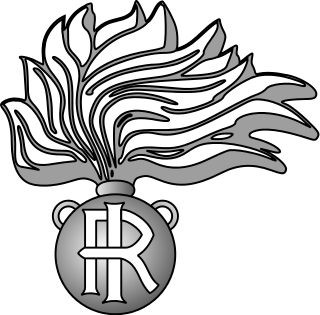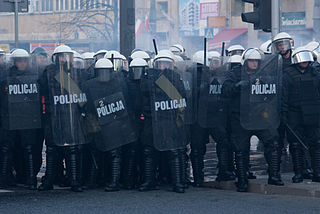
The Italian Armed Forces encompass the Italian Army, the Italian Navy and the Italian Air Force. A fourth branch of the armed forces, known as the Carabinieri, take on the role as the nation's military police and are also involved in missions and operations abroad as a combat force. Despite not being a branch of the armed forces, the Guardia di Finanza has military status and is organized along military lines. These five forces comprise a total of 340,885 men and women with the official status of active military personnel, of which 167,057 are in the Army, Navy and Air Force. The President of the Italian Republic heads the armed forces as the President of the High Council of Defence established by article 87 of the Constitution of Italy. According to article 78, the Parliament has the authority to declare a state of war and vest the powers to lead the war in the Government.

The Carabinieri are the national gendarmerie of Italy who primarily carry out domestic and foreign policing duties. It is one of Italy's main law enforcement agencies, alongside the Polizia di Stato and the Guardia di Finanza. As with the Guardia di Finanza but in contrast to the Polizia di Stato, the Carabinieri are a military force. As the fourth branch of the Italian Armed Forces, they come under the authority of the Ministry of Defence; for activities related to inland public order and security, they functionally depend on the Ministry of the Interior. In practice, there is a significant overlap between the jurisdiction of the Polizia di Stato and Carabinieri, although both of them are contactable through 112, the European Union's Single Emergency number. Unlike the Polizia di Stato, the Carabinieri have responsibility for policing the military, and a number of members regularly participate in military missions abroad.

Military police (MP) are law enforcement agencies connected with, or part of, the military of a state. In wartime operations, the military police may support the main fighting force with force protection, convoy security, screening, rear reconnaissance, logistic traffic management, counterinsurgency, and detainee handling.

A gendarmerie is a military force with law enforcement duties among the civilian population. The term gendarme is derived from the medieval French expression gens d'armes, which translates to "men-at-arms", or "rural police". In France and some Francophone nations, the gendarmerie is a branch of the armed forces that is responsible for internal security in parts of the territory, with additional duties as military police for the armed forces. It was introduced to several other Western European countries during the Napoleonic conquests. In the mid-twentieth century, a number of former French mandates and colonial possessions adopted a gendarmerie after independence. A similar concept exists in Eastern Europe in the form of Internal Troops, which are present in many countries of the former Soviet Union and its former allied countries.

A carabinier is in principle a soldier armed with a carbine, a musket or rifle commonplace by the beginning of the Napoleonic Wars in Europe. The word is derived from the identical French word carabinier.

Riot police are police who are organized, deployed, trained or equipped to confront crowds, protests or riots.

Law enforcement in Italy is centralized on a national level, carried out by multiple national forces, helped by few limited local agencies. The Italian law enforcement system is considered complex, with multiple police forces and other agencies taking part in different duties. Policing in the Italian system refers to the duties of "full-powered officers" coming from the four national main forces: Polizia di Stato, Carabinieri, Polizia Penitenziaria and Guardia di Finanza. While the duties of these four corps' include investigating arresting, other local forces carry out limited duties.

The Italian Special Forces include special forces units from several branches of the Italian Armed Forces: the Esercito Italiano (Army), the Marina Militare (Navy), the Aeronautica Militare and the Arma dei Carabinieri (Gendarmerie).
A number of words are derived from the carbine firearm:

Zaptié was the designation given to locally raised gendarmerie units in the Italian colonies of Tripolitania, Cyrenaica, Eritrea and Somaliland between 1889 and 1943.

The Gendarmerie Corps of Vatican City State is the gendarmerie, or police and security force, of Vatican City and the extraterritorial properties of the Holy See. It was founded in 1816 as Corps of Gendarmes by Pope Pius VII, renamed the Central Security Office in 1970, the Security Corps in 1991, and was restored to its original name in 2002.

The Trupele de Carabinieri is the national gendarmerie force of the Republic of Moldova, under the administration of the Ministry of Internal Affairs of Moldova. The Moldovan Carabinieri are to ensure, together with the police or independently, public order, protection of rights and freedoms of citizens, owners' properties and prevention of violations of the law. The structure of the agency is based on the Italian Carabinieri, where it gets its name. The Department of Carabineer Troops has 5 Military Units and some 2,000 soldiers working on a contract basis or on time.

The 2003 Nasiriyah bombing was a suicide attack on the Italian Carabinieri MSU headquarters in Nasiriyah, Iraq, south of Baghdad on 12 November 2003. The attack resulted in the deaths of 18 Italian servicemembers, mostly members of the MSU Carabinieri, an Italian civilian, and 9 Iraqi civilians and was the worst Italian military disaster since the Second World War. The attack, labeled a "terrorist act" by Italian president Carlo Azeglio Ciampi, was among a string of many attacks on non-American military international targets in Iraq that occurred shortly after the end of major combat operations, including the Jordanian and Turkish embassies, International Red Cross, and UN facilities.

Carabineros de Chile are the Chilean national law enforcement gendarmerie, who have jurisdiction over the entire national territory of the Republic of Chile. Created in 1927, their mission is to maintain order and enforce the laws of Chile. They reported to the Ministry of National Defense through the Undersecretary of Carabineros until 2011 when the Ministry of the Interior and Public Security gained full control over them. They are in practice separated fully from the three other military branches by department but still are considered part of the armed forces. Chile also has an investigative police force, the Investigations Police of Chile, also under the Interior and Public Security Ministry; a Maritime Police also exists for patrol of Chile's coastline.
The 1st Carabinieri Paratroopers Regiment "Tuscania" is a special operations unit of the Italian Carabinieri. Together with the 7th Carabinieri Regiment in Laives, the 13th Carabinieri Regiment in Gorizia, and the Special Intervention Group it forms the 2nd Carabinieri Mobile Brigade. The regiment is based in Livorno, and has approximately 550 personnel.

Don Matteo is an Italian television series that has been airing on Rai 1, Italian national television's first channel, since 2000.
As the Arma dei Carabinieri is the fourth service of the Italian armed forces, the Ranks and rank insignia of the Carabinieri are designed according to the military rank structure of Italy. Carabinieri personnel belongs to four different career paths, the Officer career, the Inspector career, the Sovrintendente career, and the basic Carabinieri career.
Carabinier originally a cavalry soldier armed with a carbine, may also refer to the following:

The White Uno Gang was an Italian criminal organization operating mainly in Emilia-Romagna and Marche.














